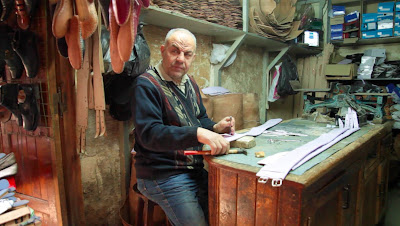I will make no attempt here to describe all that I have seen or experienced during my days and nights on the Nile, of the exquisite tombs of the Pharaohs I entered, the temples I explored, open mouthed, and dumb founded, nor any of the stories of the 700 deities, their cults and priestly ceremonies, or the 3000 year history of the Pharaohs, that Ahmed—my guide, philosopher and teacher —spoke of, and whose brooding silences so perfectly matched my own, especially at breakfast time—who knew instinctively during our daily excursions when it was high time for coffee, a smoke and a sit down, and was wise enough not to talk incessantly, like most guides, about everything he knew, in fact to remain gratifyingly silent until I enquired—What is that? Or the slow-moving vista unfolding relentlessly on both banks of the river as we sailed south against the strong current. Landscapes of date palms, fields of sugar cane, sand dunes, sandstone cliffs, low islands of reeds and water lilies, farmers with their cows, galibaya-shrouded women carrying jars of Nile water on their heads at sunset, small boys in impossibly tiny boats rowing with 4x2s for oars, the countless mosques in sun baked towns with the muezzin's call to prayer carrying clearly across the water, cruise boats returning downstream to Aswan, sans tourists, hooting and tooting. Or navigating the great locks at Esna, and how touts and merchants in tiny motor boats attach themselves to our vessel—which never slows—and hold up their wares and shout greetings and pleas in several languages to our reluctant passengers, to buy all manner goods, which are then rolled into tight bundles and lobbed high in the air from below, to much laughter, clapping, cheers and shouting. Or watching the sun set over the Nile's western bank, and seeing Jupiter, Venus and the crescent moon in conjunction in the westering sky, is to die. Or riding in the early morning by horse and carriage with dozens of other tourists from the the dockside melee at Edfu to visit the great Temple of Horus, and so on. No words or pictures could convey all this. To say nothing of how the entire surface of every wall and ceiling of every chamber in every ancient temple, tomb, large or small, is incised, carved, drawn upon or painted brightly in the most exquisite ways, and imagine the impact this had on the simple farmer or stone mason who lived in simple mud brick houses. And bless those 21st century idiots who don't know how to turn off the flash on their digital cameras, which now necessitates the complete ban on any photography whatsoever in these fragile chambers, so that you are forced to give complete attention to the staggering artistry of the hieroglyphics and uncountable, scenes depicting the heroic afterlife of the Pharaoh, his offerings to the gods, triumphs over his enemies, the obsessive recording of knowledge, calendars and ancient technology, science, medicine, wine-making, agriculture, the butchering of animals, food preparation and so on. Or the representation of thousands of priests ceaselessly enacting the sacred rituals, or the Pharaoh's vanquished enemies, covering—as I said before—every surface of the burial chamber—floor, wall and ceiling, then loaded with fabulous treasures and trappings, fit for a Pharaoh in his eternal afterlife with all the necessary royal clothing, bedding, furniture—domestic and ceremonial—folding thrones and beds, suitable for travel or hunting—all gilded inside and out or inlayed with exotic hardwoods and precious stones, all manner of boats and barges, large and small, chariots, and provisions of every sort, containers for scents and lamps, and finally jewelry of lapis lazuli, carnelian, quartz, obsidian, turquoise and glass and faience—jewelry that surely inspired Lalique and Tiffany, then all of this hoard placed within gilded shrines nested within gilded shrines, exquisitely carved, foretelling the glorious afterlife, and finally the stone sarcophagi, containing the mummiform coffins nested within coffins which at last enclose the Pharaoh's—the living God's—dazzlingly masked, banded and bejeweled mummy, sealed for all eternity. This has to be seen by one's own eyes to be believed. And, as I stated above, I will make no attempt to describe all this. All I can say for certain, as an eye witness to these achievements, from the near perfect stone masonry and precise carving of stones weighing a staggering 25 tons or more, down to the finest, detailed, gilded and inlaid jewelry—this is categorically
not the achievement of the resentful, forced labour of slaves.
(Composed on a Saturday night during the consumption of only 3 glasses of wine at a buzzing, shish-smoking bar and restaurant filled to capacity with local literary and revolutionary types, on Zamalek, an island in the middle of the River Nile, Cairo.)










































